We also noted in the earlier article that a gentleman named Loray Greiner is trying to do something about it. Mr. Greiner lives in La Garita, Costa Rica and comes from a family that knows cattle. He inherited from his father some 30 years of work experience developing new breeds of cattle and new types of feed grasses.He's serious about bringing good beef to Costa Rica.
Loray has been crossing a number of different breeds. Indian Brahmin type cattle due well here because of their resistance to heat and insects. Greiner has been crossing Brahmin and Angus to come up with a breed he christened "Brangus". He's also trying to cross-breed Japanese Wagyū with angus. Wagyū is the source for internationally acclaimed Kobe beef, reportedly the most tender in the world.
Before I became GG, the Golden Gringo, I had a Kobe steak in Brussels in the 1970's that was absolutely incredible. Unlike the Japanese method however, Greiner's cattle won't be mistreated by hanging them in a sling to avoid muscle development and maximize tenderness. And, for those who follow this kind of thing closely, Loray prides himself on having only pasture-grazed cattle with no hormones or antibiotics.
At the end of August, Greiner announced that he had been successful not only at his cross-breeding activity but also in perfecting a dry-aging process that promotes tenderness in the meat. Proper aging has been another missing ingredient in typical Costa Rican beef. (The old joke used to be: Q. "How do you tell when a Costa Rican steer is properly aged?"; A. "When it falls over in the pasture!")
As you might expect, this kind of beef is not cheap, although the cost may improve with volume in the future. The current cost of this beef is from 8,000 to 20,000 colones a kilo ($7-17 per pound). That's quite a range. Still, this is not prohibitive or completely unusual for beef in Ticoland; just see last month's ROMEO Review where a U.S.D.A.-Choice filet mignon estimated at 12 ounces at a restaurant in Quepos was priced at 21,000 colones (about $60 per pound). Leaves room for Brangus, don't ya think?
Keep going Loray, you've got a market to fill.
I'm a fan of headlines, particularly the ones that in this humble reporter's opinion make no sense whatever.
What? We needed a study to tell us that people who pay to use other people's bodies for sex might have less esteem for the person used than someone in a normal relationship? Wonder who funded this important study, the Feds?
In the past, the area on which the new plaza has been built ran the whole block between two streets. It was unpaved and served as a parking lot, particularly for pirata and porteador taxis (see What's-in-a-Word section below for the meaning of these terms). About three quarters of the new plaza has now been paved and landscaped into a walking area. It's not yet clear whether or not any of the old parking space will remain (the paving looks like it is incomplete). If more is to be done, where will all those pirata/porteador taxis go amigos??? Once more the municipalidad has found a way to eliminate critical parking spaces in downtown Quepos (see Parking Regs Lifted).
The name seems a bit pretentious for such a modest project in Quepos, but let's see how it works out. I would have named it Plaza Quepoa, after the original natives in this area, but then, once more, nobody asked me.
It was the size of a small plum, red and orange on the outside. I had seen them before but passed them off as just another tropical fruit of which I had no knowledge (there are still many of those for me). As I was pondering how to eat it, Peluca simply bit into one he was holding through the thin outer skin so I followed suit. I was met with a wonderful sweet taste, kind of like a combination of mango and papaya. One bites into them with care as the flesh of the fruit is less than a quarter of an inch deep between the skin and the large nut at the center. The nut seems like its 2/3 of the diameter of the whole fruit. Bite too hard on that sucker and you'll need repair at a dentist.
On the way home that afternoon I came across a plastic box of jecotes in the produce section of a grocery store and immediately bought it. Evidently this time of year brings on a wide variety of tropical fruits including jocotes and also, my all-time favorite, mamones. Half the jocotes in the box were green and unripened and I wondered if they'd ripen. After laying them out on a table, they were ripe and ready two days later. Ummmmm...and oh so sweet.
Rumble Talk
(Shaky Happenings On or About the Pacific Rim)
LIttle rumble action in Costa Rica again this month. The biggest rumble was a shaker centered 7 kilometers north of the Panama border town of Paso Canoas on September 19. At a Richter level of 4.4 and depth of 23 kilometers it moved things a bit but there was no significant damage nor injury reported.
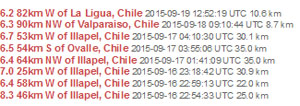 |
September Quakes in Chile |
The real action during the month was in Chile where there were at least eight quakes greater than 6.0 on the Richter scale just off the Pacific coast north of Valparaiso. The list of those quakes at the left was taken from the USGS monitoring system (link below); the first number on a line is the intensity and the last is the depth.
Those sizeable shakers all occurred within three days, from September 15 to the 17th and included an 8.3R on September 16th at a depth of 25 kilometers. I can imagine that that one was even more fun than the 7.6 terremoto that hit the Nicoya on September 5, 2912 (depth 41 km). GG remembers the Nicoya shaker well as I was visiting the 10-story hospital in Puntarenas when it hit and mortally damaged the building. The top eight stories of the hospital were subsequently razed and the building is now a two-story edifice housing hospital administration offices.
There is no rest for the wicked living on the Pacific Rim.
Check Out Recent Earthquakes Around the World
Posted by the U.S. Geodetic Survey: Today's Quakes |
Riding Canopy Bici
(Hang Gliding for Ancianos)
One of the things tourists do often here is taking a tour into the forest canopy. This usually means hanging oneself in a body harness from an overhead track on which there are wheels to move you along.
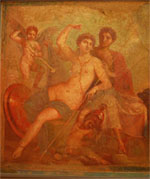 |
Pompeii Mural |
Riding the canopy is one of those things GG has never been very enthusiastic about but I knew I'd just have to do it sometime if for no other reason than just because I live here.
Visiting a volcano (Arenal, Turrialba or others) also falls into this personal bucket list category to delay experiencing. I've been cold on the volcano thing as I had been to the top of Mount Vesuvius in Italy some years ago and was underwhelmed by that visit. At the top of the volcano we found a large crater punctuated by steam vents and housing a green acid lake. It didn't thrill me as maybe it should. I much more enjoyed the tour of the city at its base, Pompeii, with its ancient murals on bordello walls which are now museum art. But I diverge again.
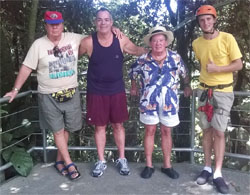 |
The Canopy Crusaders:
GG, Don, Brian and Lou (Staff) |
Recently a new canopy tour was initiated right here on Manuel Antonio mountain and it offered a twist in it's approach that interested me. It's called Canopy Bici and the twist as advertised is that you can ride in a frame that imitates riding a bicycle, hence (I suppose) the name "Bici". What, you mean I can ride, not hang like a smoked pork leg? Sign me up.
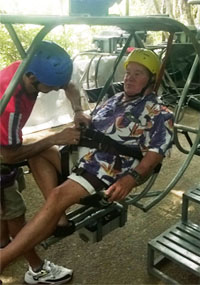 |
Getting Strapped In |
So one day recently I enlisted a couple of friends who were game enough to accompany me and we headed for Canopy Bici, which is located 50 meters down the hill from the Avion restaurant on top of Manuel Antonio hill (some would say mountain). The ride shares
ownership with the Avion as it's all part of the Costa Verde empire started by an enterprising fella some decades ago..
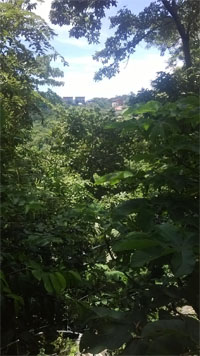 Being late in September the tourist traffic was minimal and we quickly obtained our tickets (6,000 colones or just over $11). Then we were led to a platform where three of the "cars" were lined up for us. We were then each fitted for a harness and helmut, strapped into our respective cars and instructed on how to move the car forward using a battery powered motor with a hand control similar to that found on a motorcycle. We were also cautioned on how to use a brake on the downhill part of the run and to slow down at the junction points where the roller carriage had to traverse a support joint. After doing that a couple of times, the cautionary made sense to me as the unexpected bump felt a little destabilizing.
Being late in September the tourist traffic was minimal and we quickly obtained our tickets (6,000 colones or just over $11). Then we were led to a platform where three of the "cars" were lined up for us. We were then each fitted for a harness and helmut, strapped into our respective cars and instructed on how to move the car forward using a battery powered motor with a hand control similar to that found on a motorcycle. We were also cautioned on how to use a brake on the downhill part of the run and to slow down at the junction points where the roller carriage had to traverse a support joint. After doing that a couple of times, the cautionary made sense to me as the unexpected bump felt a little destabilizing.
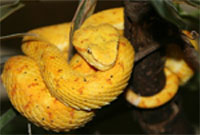 |
A Fer de Lance
(They're Not Always Yellow) |
The whole ride only takes about 10-15 minutes depending on how fast you turn up the speed control, particularly on the downhill parts. The view is what one would expect of the rainforest, lots of greenery, filtered light and a sense of being with nature you don't get in an automobile. One advantage of doing it this way versus just walking through the jungle (it's often suggested that such a walk be done only with a guide) is that you don't have to worry about surprising or startling a fer de lance or terciopelo, two of the most venomous snakes in the world we have in the jungle here. Nasty little devils, not to be disturbed.
There's another advantage to the Bici ride for GG. It befits the activity level to which I have become accustomed in my senior years. The Bici ride is like hang gliding for ancianos (see this word below in What's-in-a-Word).
Yeah, I don't surf anymore either.
¡Solo Bueno!
TOP
Arcos Dorados
(Franchise Food Fluctuations in Ticoland)
Arcos Dorados simply means "Golden Arches", an appropriate name for the company that represents McDonald's Corp. in Latin America.  Actually, Arcos Dorados operates more than 2,100 restaurants spread out through 20 countries in Central America (including Panama and Costa Rica), Mexico, South America (Argentina, Aruba, Brazil, Chile, Colombia, Curaçao, Ecuador, French Guyana, Guadalupe, Martinique, Peru, Uruguay, and Venezuela and the Caribbean (Puerto Rico, St. Croix, St. Thomas, Trinidad & Tobago). The company's Latin American franchise region also includes 343 McCafés (Coffee and pastries stores similar to Starbucks) and 2,494 "dessert centres", mainly ice cream kiosks many of which are attached to their restaurants like is done in San José. That business footprint leaves some 20 other countries in the region devoid of Big Macs, so there's plenty of room for eventual expansion.
Actually, Arcos Dorados operates more than 2,100 restaurants spread out through 20 countries in Central America (including Panama and Costa Rica), Mexico, South America (Argentina, Aruba, Brazil, Chile, Colombia, Curaçao, Ecuador, French Guyana, Guadalupe, Martinique, Peru, Uruguay, and Venezuela and the Caribbean (Puerto Rico, St. Croix, St. Thomas, Trinidad & Tobago). The company's Latin American franchise region also includes 343 McCafés (Coffee and pastries stores similar to Starbucks) and 2,494 "dessert centres", mainly ice cream kiosks many of which are attached to their restaurants like is done in San José. That business footprint leaves some 20 other countries in the region devoid of Big Macs, so there's plenty of room for eventual expansion.
Nevertheless, Arcos Dorados has reached almost $4 Billion in sales, employs some 95,000 people, is ranked 5th place in the Great Place to Work in Latin America listing and has been traded on the New York Stock Exchange (ARCO) since 2011. The company reportedly is the largest McDonald's franchise in the world, representing one in six of the countries where McDonald's is internationally franchised.
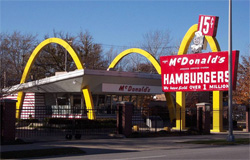 |
Now a Museum, This was Rebuilt on the Original Site in Downey, CA |
Many know the story of Ray Kroc, the patriarch of McDonald's who was a milkshake mixer salesman and who, in 1953, came across two brothers named McDonald operating a restaurant in Downey, California. He met them just after they had redesigned their store with the now familiar arch. He was so impressed with the efficiency of the brothers' operation that he bought a franchise for Chicago in 1955 and, more importantly, he convinced the brothers to let him buy the franchise rights for McDonalds across the country. Kroc then became the sole owner of the company (1961), buying out the brothers, and the rest is history. Kroc died in 1984 at the age of 82.
The first McDonald's outside the United States was in Richmond, British Columbia, Canada in 1967 but the McHistory of the golden arches in Costa Rica is interesting. San José is home not only to the first McDonald's restaurant in Costa Rica but also to the first outside of North America. That store still exists and can be found across from the entrance to the Central Bank of Costa Rica next to the flower market (between Avenida Central and Avenida 1 on Calle 4). In sales, that store has been eclipsed by the very busy one on Avenida Central across from Plaza de la Cultura (been there a few times myself). Arcos Dorados now has 55 restaurants in Costa Rica, almost all in the greater San José metropolis.
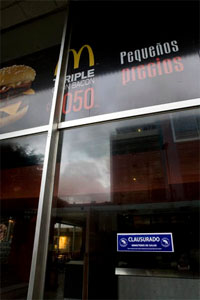 |
Mac #1 in San Jose on Closure Day |
Costa Rica Store #1 was closed briefly on 2011 on a complaint by a customer that the store did not comply with the new disability access law which had just been enacted at that time. The health department took the opportunity to find a number of other violations, some technical (e.g., their operating license expired 30 days earlier) and some more serious (e.g., handling of waste water). The old building was brought up to date and the restaurant soon reopened.
You don't go to a McDonald's for haute cuisine, you go there because it's predictable. You know what a big mac with fries will taste like, you expect to receive it quickly and you don't expect to pay a lot of money. In the early decades, the menu was simple; a few variations on burgers and fries. And Kroc instituted precise portion control and instilled in his people a mantra to be followed: Q.S.C. & V. or Quality, Service, Cleanliness and Value. These simple rules allowed for easy replication and fueled the explosive growth that resulted in the modern company with more than 36,000 stores worldwide in 2015. Company-founded Hamburger University provided the training (Q.S.C. & V.).
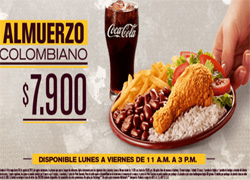 |
Big Mac Option in Bogotá |
But these days competition is so intense that fast food chains have been looking for ways to attract more customers. One way to do this is to vary and expand their menus and offer more local flavor. Arcos Dorados has been one of those pursuing that strategy (methinks Ray Kroc would turn over on his celestial griddle if he knew).
At a McDonald's In Costa Rica you can get scrambled eggs with gallo pinto and fried plantains in the morning or tortilla wraps with bacon for lunch. At Micky D's In Colombia, you can get an Almuerzo Colombiano (Colombian lunch - see poster left) that looks more like a typical home dinner plate than a McDonald's meal. The $7,900 refers to Colombian pesos which were about 3,004 to the dollar at this writing so the price is about $2.62 - now there's a deal.
The bad side of this attempt at varying and tailoring the menu to perceived local customer taste (N.B., GG is now entering the realm of editorial opinion) is that the operating focus often gets diluted, which means longer waiting on line for your burger. Overheard at a McDonald's in San José recently: "Whatever happened to the fast food business?" Must have been a visiting gringo.
And financially all is not well in the very competitive world of franchised fast food these days nor is it easy for such businesses in Costa Rica. The parent company to Arcos Dorados, McDonald's Corp, has had stagnant revenues and profits for the last four years. The market has been fragmented into levels by regional chains that offer more elaborate and more expensive burgers and other "fast" food.
McDonald Corp. showed revenue in 2014, for company-owned restaurants (6,714) and franchise fee revenue, together, of $27.4 billion. In 2011 that figure was virtually the same - $27.0 billion.
Add to that sales of $69.6 billion by the franchised stores themselves and the "system" is producing nearly $100 billion worldwide. That's twice the gross domestic product of Costa Rica and it's difficult to show growth when the base is that large. Arcos Dorados still showed profitability ($114 million net profit of sales of nearly $3.8 billion or 3% NPAT) in 2014 but the margin is thin. Other fast food chains here have not been nearly as lucky, or maybe the right word is astute.
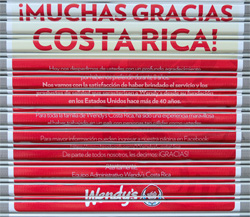 |
Sign on Wendy's Doors Thanking Ticos for Their Past Business |
Burger King recently closed four restaurants reducing its foot print to 29 locations in Costa Rica. Wendy's closed the door on all 14 of its locations and pulled out of Costa Rica completely. Bagelmen's, an upscale food chain also closed its seven locations here, citing that the exchange rate and higher operating costs for electricity and fuel had effected their performance. Many business people see the economy here as floundering.
The government is finding it difficult to balance its budget as it promised in last year's election. The budget is operating on nearly a 50% deficit requiring mounting debt. To boost revenues, the current administration wants strong tax increases (13% sales tax to 15% VAT, a new 15% income tax and a 15% tax on ex-pat income). They're finding strong resistance to this plan (rightly, methinks, as it would also further kill the economy).
The consensus is that economically challenged Costa Ricans are opting for the more budget oriented dining establishments and I'll bet my money on Arcos Dorados surviving the current machinations of the economy and the fickle finger of fate in fast food franchising here (I know; I'm incorrigible when it comes to alliteration).
And that's my McPrediction, amigos.
¡Pura Vida!
TOP
Ticoland Uber Alles
(Press 1 to Get a Pick Up, Press 2 to pay)
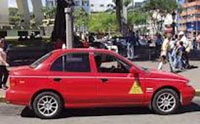 |
A "Regular" Taxi |
Costa Rica has always been a land of competing interests when it comes to taxis. We have the regular and highly regulated red taxis that have a yellow triangle on the door with their license numbers painted inside the triangle. These are the "official" ones.
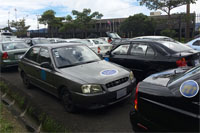 |
A Bunch of Porteadores Gathered in San José |
But there also are pirate taxis or "piratas", although Costa Rican political correctness at the moment suggests they be called "porteadores". These were unlicensed and largely unregulated until recent years. In the past, if you wanted to be a taxi, you just got a car and started beeping your horn and flashing your lights at potential riders to get fares. Very enterprising and entrepreneurial.
These days, porteadores are being somewhat regulated, particularly in the central valley, and are restricted to picking someone up at their origination and delivering them to their destination. Supposedly, porteadores don't cruise the streets of San José to pick up clients but I'm told that in practice they do. In Quepos we also have a goodly number of porteadores and also a number of piratas offering vehicles in various stages of disrepair. Many are driven by Indy 500 wanna-be's and can be found on virtually every corner or clustered behind the bus station. The long and strong arm of San José doesn't seem to reach into Quepos nearly as much to restrict the porteadores and piratas to the rules and regulations.
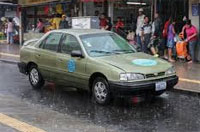 |
A Quepos Porteador |
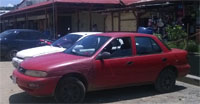 |
A Quepos Pirata |
In Quepos the porteadores and piratas hang out behind the bus station and cruise around town honking and flashing at their pleasure. When GG makes his monthly trip to the hospital for his allotment of medicines, I usually pick up the bus in front of Pali Supermarket, a couple of bocks from home. Sometimes I wait ten to fifteen minutes before the bus comes; during any ten minute period one can be solicited by upwards of ten of these entrepreneurs. I snapped a couple of pictures of them; the one to the left is in pretty good condition, the one to the right is also available for hire.
 Enter Uber Technologies, Inc. into the marketplace. Stampede might be a better word for the way this company enters markets. Since its founding in 2009 by two San Francisco tekkies, Uber has expanded not only across the U.S. but into other countries. Uber's market cap value is now estimated to be more than $40 billion. Not even Microsoft was able to match going from zero dollars in year one to that level in six years. Uber's business model has now been copied by other start-ups, a process called "Uberification".
Enter Uber Technologies, Inc. into the marketplace. Stampede might be a better word for the way this company enters markets. Since its founding in 2009 by two San Francisco tekkies, Uber has expanded not only across the U.S. but into other countries. Uber's market cap value is now estimated to be more than $40 billion. Not even Microsoft was able to match going from zero dollars in year one to that level in six years. Uber's business model has now been copied by other start-ups, a process called "Uberification".
Uber's business model is based on a smart phone app that its founders developed at the company's inception and is the reason why the company is called Uber Technologies and not Uber Taxi Co. You can download the app at "app stores" such as Apple and Windows. Simply download the app and call for a quote and schedule a time for pick-up. The exact location is determined by the app using the GPS reading of the smart phone. You indicate your destination and choose the type of car: regular, larger for multiple fares or luxury. You will be told the fare, the color and make of the car as well as the name of the driver that will meet you. The first time you use the app, your credit card info will be stored in the app. Your card will be charged at your destination.
Experience suggests you're likely to get a modern, comfortable, air conditioned car - some drivers even offer amenities like candy and soft drinks. The world is changing, amigos, largely thanks to technology such as smart phones. No more standing in the rain trying to flag down an available taxi. No more guess work on what the taxi driver is really going to charge you or which route he's going to take - you know the fare beforehand.
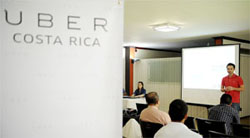 |
Uber Driver Training in San José |
Uber's first operation outside the U.S. was in Paris in 2011. Since then, the company has launched operations in Toronto, London, Sydney, Singapore, Johannesburg, Seoul, Cape Town, Tijuana, Bogotá etc., etc. Uber's current website states it now has operations in 60 countries and over 300 cities worldwide.
 |
Humberto Pacheco |
And now Uber has come to Costa Rica, although it's not exactly been welcomed with open arms. Uber's general manager here, Humberto Pacheco (left - not sure if there's a connection but Pacheco is a familiar name in Costa Rica being that of a former president), is busy training drivers and entering into agreements with credit companies so drivers can purchase cars on favorable terms and also providing group purchasing for insurances. Drivers are under contract to provide service according to Uber standards. Uber's position is that they are contract agreements and are not employees of Uber.
 In the first three days of operation in Costa Rica, Uber reported over 4,500 downloads of its app. To stimulate business, the company is offering the first two rides to any customer free (up to a maximum of 5,000 colones total). One of Uber's first customers was a well known model and business woman, Leonora Jimenez, shown stepping out of an Uber taxi in the photo to the right. (Makes some of us want to be an Uber driver, right guys:?)
In the first three days of operation in Costa Rica, Uber reported over 4,500 downloads of its app. To stimulate business, the company is offering the first two rides to any customer free (up to a maximum of 5,000 colones total). One of Uber's first customers was a well known model and business woman, Leonora Jimenez, shown stepping out of an Uber taxi in the photo to the right. (Makes some of us want to be an Uber driver, right guys:?)
Uber views its business as being outside the regulatory arm of the law. It sees itself as a private agreement between a provider and a user and therefore not subject to regulations. An investigation team from Telenoticias, the Costa Rican news channel, decided to test Uber versus a red taxi, taking both on a 5.7 km (about 3.5 miles) ride from San José's second airport, Tobias Bolaños in Pavas to the electric company's (ICE) headquarters near La Sabana park. The red taxi took 12 minutes and five seconds and cost 3,775 colones (about $7.15); the Uber vehicle took 13 minutes and 20 seconds and cost ¢2.896 (about $5.45 - that's 18% less). The Uber driver offered candy and soft drinks and more air conditioning.
Not all the initial Uber reports have been favorable. A recent report in QCosta Rica told the story of a non-Spanish speaking lady who had difficulty communicating with the person at the Uber office who couldn't speak English (I thought the app overcame that - why did she need to call the office?). And her experience was compounded by unavailability of Uber cars when she wanted them. Evidently, there are still start-up problems to be worked out, Uber amigos
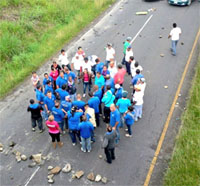 |
Porteador Strike Blockade |
As you might expect, government regulators and existing taxi drivers don't agree with Uber's belief that they are exempt from regulation and both are ready to fight. The government sees loss of control and tax revenues while the drivers worry about the competition (can't think of an industry that needs this last factor more than the taxi industry). Uber's first two cars used in Costa Rica that the Ministerio de Obras Publicos y Transportes (MOPT - kinda like DOT) could catch were impounded and the drivers fined for illegal transport. The battle is on.
Taxi drivers, including porteadores are threatening major strikes - and they're good at shutting down highways (see pic of a strike at right, although that particular one was to protest the government's new restriction aimed at cutting the number of porteador licenses in half).
Around the world Uber has run into other problems as well. In India some Uber drivers went on strike to protest high operating costs caused by high interest rates that Uber had arranged on purchasing their cars - they feel misled by Uber on how much money they could make. Uber has been completely banned in parts of India, Thailand and Japan and partially banned in parts of Europe (e.g., Germany, Netherlands, Belgium - c'mon, have you ever taken a taxi in Brussels - there's room for improvement there don't ya think?).
Methinks it would be advisable for the more traditional taxi operations to join in the parade and perhaps modernize their operations, in a fashion copycatting Uber. The idea that a customer can order up a taxi on his or her phone, when and where they need it, enjoy a comfortable ride for a modest price is a natural outfall of today's technology and an idea that's not going to go away. Current taxi operations should recognize that.
Ticoland alles Uber, amigos.
¡Pura Vida!
TOP
Travel Quote of the Month
Flight attendant announcement on landing:
"Weather at our destination is 50 degrees with some broken clouds, but they'll try to have them fixed before we arrive. Thank you, and remember, nobody loves you or your money, more than
Southwest Airlines." |
What's-in-a-Word
Anciano
Old man. An old woman would be an anciana.
Pirata, Porteador
Pirata = pirate, like in Blackbeard or Barba Roja (Redbeard). A pirata, when applied to taxis, is one that is unlicensed and unregulated.
A porteador is, literally a "porter" or bearer or carrier. What semi-regulated taxies like to call themselves.
TOP
ROMEO Corner
(Retired Old Men Eating Out)
Kapi Kapi - Manuel Antonio
Location: Top of Manuel Antonio Hill, 50 Meters North of Victoria's Restaurant, Across the Street from Condominiums La Reserva
Hours: 4-10 PM, Dinner Only
Parking: Off-street at the restaurant
Contact: Tel.: 2777-5049; Email: kapikapi@racsa.co.cr; Website: www.restaurantekapikapi.com/
Reviewing ROMEOS: Brian M., Bob N.
To Review Our Rating System and Procedure, go here: R.O.M.E.O. Rating System
This restaurant was first reviewed by the ROMEOs in January of 2011. To see that review go here:
Kapi Kapi January 2011
Little has physically changed with this restaurant since 2011. It's still recessed some 50 meters from the main Manuel Antonio road, still has a rather dark and lengthy access ramp to the dining room. The dining room is also darker than it needs to be (the ROMEOS couldn't be aging, could they?) and the single tealight candle on the table in no way could provide enough light to read the menu. We were the only diners at 6 PM on a late September evening, the slowest period of the year. Many restaurants and other establishments in this area actually close for a week or two during September.
The room is still decorated in warm colors and the tables are dark hardwood squares and rectangles with padded seats (yeh!). The warmth of the room would be more apparent in the daylight. The tables only offered place mats and simple stainless cutlery. Basic but pleasant. We have to give the restaurant only 3-1/2 sloths for atmosphere, mainly because of the lighting and walking difficulties.
The menu has also been trimmed a bit since the restaurant's early days. Of the limited (10 items) on the entree list, only one was beef, most of the others were some form of seafood. I was hoping to find the coffee and Sambuca marinated lamb chops I raved about on the earlier visit - not to be this time. The reduction in menu size found on this visit might also be temporary and related to the off-season.
GG chose, as a first course, something billed as an Asian lettuce wrap filled with a fine mince of chicken, carrots and nuts flavored with asian spices - unusual and delicious. I chose the macadamia encrusted mahi-mahi for an entree on the suggestion of our waiter. It was served with plain white rice, a medley of steamed veggies including pea pods and a white butter sauce that well complimented the fish. All was delicious.
My dining partner declined an appetizer and chose a shrimp ravioli that he described as light on flavor and light on amount.
Being the chocoholics that we are, we both opted for a chocolate concoction our waiter suggested. It consisted of hot, caramelized chocolate over some chocolate cake and topped with a large ball of vanilla ice cream. It was an interesting variation on the all too standard brownie with ice cream dessert prevalent in this area.
|
 |
|
$$$$$ |
Value Index = 80 |
For food we give Kapi Kapi four sloths on this visit.
Our waiter provided very good service, suggesting at one point to opt for the fish versus the beef and on another occasion, when I commented that I couldn't read the menu in that light, quickly provided a small, standing, battery-powered lamp to read by. For service we give Kapi Kapi 4.5 sloths and an overall rating of four sloths for atmosphere, food quality and service.
My partner's bill for two courses, the shrimp ravioli and the chocoholic dessert came to 19,000 colones ($36) including the mandatory 10% service and 13% sale tax. My three courses of lettuce wraps, mahi-mahi and the chocolate thing plus a coke and a cup of coffee came to 28,500 colones ($57). This puts Kapi Kapi at the top of the cost comparison chart at 5$ and gives Kapi Kapi a Value Index of 4sloths/5$ x 100 = 80, a bit of a drop in value from the previous review.
Golden Gringo Chronicles Novel and E-Books Now Available!
 The story of the Golden Gringo Chronicles is also available as a hard copy novel of 192 pages available through Amazon and all major online retailers. ($9.95)
The story of the Golden Gringo Chronicles is also available as a hard copy novel of 192 pages available through Amazon and all major online retailers. ($9.95)
Amazon link: GGC, the Book. (Kindle Edition available)
Follow GG through the first six years of his odyssey in making the decision to retire in Costa Rica, overcoming the trials and tribulations of moving and obtaining residency there and the fun and experience of actually living in Ticoland.
Ride along with the Golden Gringo as he learns about the rich, varied culture of Costa Rica, the incredible bio diversity, the charming nature of the Costa Rican people and the ease with which a sometimes clueless ex-pat can assimilate into a small southwestern town on the Pacific coast.
Whether you are already a Costa Rican resident, someone contemplating a move here or just a traveler who enjoys different cultures, you will find the Golden Gringo Chronicles interesting, entertaining and informative about Costa Rica.
A narrative version of the Golden Gringo Chronicles is now also available as a trilogy of E-books in formats compatible with virtually all electronic platforms.
Part 1: (FREE!)
Leaving the Homeland
Part 2: ($3.99)
The Early Years
Part 3: ($3.99)
Becoming Tico, Maybe
Click on Part Number above for E-book sample downloads or click the price above right for purchase. (The best price is on Part 1; it's FREE)
Opt-In Here to Receive Your Free Copy Monthly
The Golden Gringo Chronicles is a free newsletter that is non-political, non-commercial and, hopefully, entertaining. By signing up you will receive an email each month around the first of the month giving you the links to the latest edition as well as to each individual feature and departmental section.
CLICK HERE TO SIGN-UP FOR THE
GOLDEN GRINGO CHRONICLES
or Email me at gg@goldengringo.com

The Golden Gringo
Pura Vida!
To Contact GGC World Headquarters (yuk, yuk) to make comments, suggest topics or criticize my bad jokes, just send an email to: bob@bobnormand.com.
Be pithy but kind; I'm sensitive.
Unsubscribe from Golden Gringo Chronicles

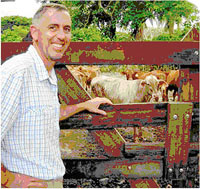
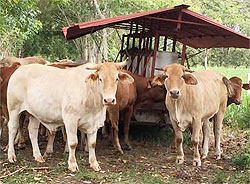
 This gem came from the news staff of the University of California - Los Angeles (yes, UCLA, that bastion of deep thought) about a recent study. The article went on to explain its major finding:
This gem came from the news staff of the University of California - Los Angeles (yes, UCLA, that bastion of deep thought) about a recent study. The article went on to explain its major finding: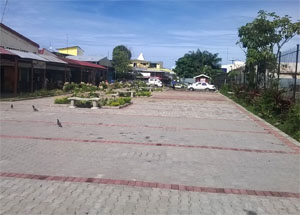
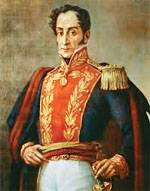 I'm told the new plaza will be named Plaza Bolivar, I presume after the early 19th century Venezuelan military dude, Simon Bolivar, who was instrumental in separating South America from Spain. After that he managed to become president for life over a vast area that ran from the Pacific to the Atlantic excepting Argentina and Brazil. President for life turned out to be about 10 years and ended December 17, 1830. Bolivar's rebelliousness encouraged the central american countries and Mexico to also declare independence later. By 1821 all of Latin America was independent.
I'm told the new plaza will be named Plaza Bolivar, I presume after the early 19th century Venezuelan military dude, Simon Bolivar, who was instrumental in separating South America from Spain. After that he managed to become president for life over a vast area that ran from the Pacific to the Atlantic excepting Argentina and Brazil. President for life turned out to be about 10 years and ended December 17, 1830. Bolivar's rebelliousness encouraged the central american countries and Mexico to also declare independence later. By 1821 all of Latin America was independent.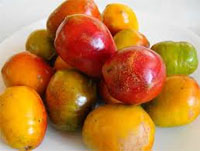 Jocotes are back. I'm sitting at the beach a few days ago and my buddy
Jocotes are back. I'm sitting at the beach a few days ago and my buddy 



 Being late in September the tourist traffic was minimal and we quickly obtained our tickets (6,000 colones or just over $11). Then we were led to a platform where three of the "cars" were lined up for us. We were then each fitted for a harness and helmut, strapped into our respective cars and instructed on how to move the car forward using a battery powered motor with a hand control similar to that found on a motorcycle. We were also cautioned on how to use a brake on the downhill part of the run and to slow down at the junction points where the roller carriage had to traverse a support joint. After doing that a couple of times, the cautionary made sense to me as the unexpected bump felt a little destabilizing.
Being late in September the tourist traffic was minimal and we quickly obtained our tickets (6,000 colones or just over $11). Then we were led to a platform where three of the "cars" were lined up for us. We were then each fitted for a harness and helmut, strapped into our respective cars and instructed on how to move the car forward using a battery powered motor with a hand control similar to that found on a motorcycle. We were also cautioned on how to use a brake on the downhill part of the run and to slow down at the junction points where the roller carriage had to traverse a support joint. After doing that a couple of times, the cautionary made sense to me as the unexpected bump felt a little destabilizing.
 Actually, Arcos Dorados operates more than 2,100 restaurants spread out through 20 countries in Central America (including Panama and Costa Rica), Mexico, South America (Argentina, Aruba, Brazil, Chile, Colombia, Curaçao, Ecuador, French Guyana, Guadalupe, Martinique, Peru, Uruguay, and Venezuela and the Caribbean (Puerto Rico, St. Croix, St. Thomas, Trinidad & Tobago). The company's Latin American franchise region also includes 343 McCafés (Coffee and pastries stores similar to Starbucks) and 2,494 "dessert centres", mainly ice cream kiosks many of which are attached to their restaurants like is done in San José. That business footprint leaves some 20 other countries in the region devoid of Big Macs, so there's plenty of room for eventual expansion.
Actually, Arcos Dorados operates more than 2,100 restaurants spread out through 20 countries in Central America (including Panama and Costa Rica), Mexico, South America (Argentina, Aruba, Brazil, Chile, Colombia, Curaçao, Ecuador, French Guyana, Guadalupe, Martinique, Peru, Uruguay, and Venezuela and the Caribbean (Puerto Rico, St. Croix, St. Thomas, Trinidad & Tobago). The company's Latin American franchise region also includes 343 McCafés (Coffee and pastries stores similar to Starbucks) and 2,494 "dessert centres", mainly ice cream kiosks many of which are attached to their restaurants like is done in San José. That business footprint leaves some 20 other countries in the region devoid of Big Macs, so there's plenty of room for eventual expansion. 







 Enter Uber Technologies, Inc. into the marketplace. Stampede might be a better word for the way this company enters markets. Since its founding in 2009 by two San Francisco tekkies, Uber has expanded not only across the U.S. but into other countries. Uber's market cap value is now estimated to be more than $40 billion. Not even Microsoft was able to match going from zero dollars in year one to that level in six years. Uber's business model has now been copied by other start-ups, a process called "Uberification".
Enter Uber Technologies, Inc. into the marketplace. Stampede might be a better word for the way this company enters markets. Since its founding in 2009 by two San Francisco tekkies, Uber has expanded not only across the U.S. but into other countries. Uber's market cap value is now estimated to be more than $40 billion. Not even Microsoft was able to match going from zero dollars in year one to that level in six years. Uber's business model has now been copied by other start-ups, a process called "Uberification". 

 In the first three days of operation in Costa Rica, Uber reported over 4,500 downloads of its app. To stimulate business, the company is offering the first two rides to any customer free (up to a maximum of 5,000 colones total). One of Uber's first customers was a well known model and business woman, Leonora Jimenez, shown stepping out of an Uber taxi in the photo to the right. (Makes some of us want to be an Uber driver, right guys:?)
In the first three days of operation in Costa Rica, Uber reported over 4,500 downloads of its app. To stimulate business, the company is offering the first two rides to any customer free (up to a maximum of 5,000 colones total). One of Uber's first customers was a well known model and business woman, Leonora Jimenez, shown stepping out of an Uber taxi in the photo to the right. (Makes some of us want to be an Uber driver, right guys:?)





